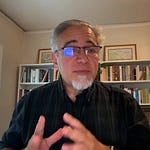As I've been sharing the Columbian Exchange with students in my Modern World History course this fall, one thing that has come up again in student questions and responses to the text, lectures, and primary sources is the vehemence of Bartolomeo de Las Casas in accusing the Spanish in the Caribbean of inhumanity. Las Casas had participated in the "pacification" of Cuba and in recognition of his contribution he received an encomienda, or a grant of territory and native workers. In Spain during the Reconquista, rewards of land taken back from the "Moors" had been a regular practice and a way that common men (hidalgos) could become aristocrats or even nobles.
In Spain, the encomendero was entrusted with helping save the souls of the people living on the land. For centuries the Iberian peninsula had been a Muslim land, but as the Reconquista moved steadily southward over the centuries toward the final Muslim kingdom of Granada (which surrendered in 1492), residents of the recovered lands were not expelled. They were just required to convert to Christianity. The encomendero was responsible to ensure that these Conversos didn't backslide or secretly practice Islam in their homes while pretending to be good Christians in public.
There was much less emphasis on spiritual responsibility in Caribbean encomiendas. They were much more about forced labor. Las Casas surrendered his grant and became a vocal critic of Spanish brutality on the islands. Undoubtedly, he was not wrong about the abuses he witnessed. I want to be clear that I don't disbelieve him when he says, to give just one example, that a couple of conquistadors came upon a couple of boys in the woods with colorful parrots on their shoulders, stole the parrots, and beheaded the boys. I agree, he was right to be appalled and to write to the King to try to stop the cruelty.
But although Las Casas' descriptions of Spanish cruelty were probably accurate, that doesn't mean his conclusion was equally correct, that a combination of Spanish brutality and native despair (suicides and killing of children to protect them from a life under Spanish occupation) completely depopulated islands like Hispaniola and Cuba. These large Caribbean islands had both been full of people, with populations between one and two million each, when the Spanish arrived. Less than two generations later, all the Taino natives had disappeared.
The Spanish had killed a lot. But a few hundred Spaniards had not been able to wipe out millions with guns and steel. This would also be the case in the Aztec Empire, which had a population of about 25 million in the empire and a couple million in the vicinity of Tenochtitlán when Cortés arrived. And the Inca Empire, which had about 11 million subjects when Pizarro arrived with his 80 soldiers.
It wasn't guns or steel. Or horses or mastiffs. It was germs.
Of course, like every other European, Bartolomeo de Las Casas had no inkling of the existence of viruses or bacteria. He saw how the Spanish colonizers treated natives and he saw native population crashing; he assumed the correlation was causal. And deliberate.
It wasn't the only cause and it wasn't even that deliberate. The Spaniards were walking petri dishes, carrying all the diseases of the old world to the new. Although they didn't do it on purpose, they were quick to take advantage of the opportunities created by pandemic after pandemic after pandemic and the social chaos they caused. When Pizarro crossed the Andes with his 80 troops in 1532, the Inca Empire was already in chaos. Both the ruler and his crown prince (and an unknown number of their subjects) had died of a European disease five years earlier, and two younger sons were fighting a civil war for the throne. What an opportunity! Pizarro helped the younger son kill his brother, before assassinating him as well and taking control of the empire.
So yeah, despicable. But not necessarily superhumanly effective on the battlefield. Las Casas can be excused for not understanding disease, I think. But why did it take until the late 1960s for a historian to say, "Wait a minute! How could a few hundred Spanish defeat empires?" The historian who finally asked that question was Alfred Crosby. In 1967 he published an article called "Conquistador y Pestilencia: The First New World Pandemic and the Fall of the Great Indian Empires". In 1972, Crosby followed the article with a book called The Columbian Exchange: Biological and Cultural Consequences of 1492. His thesis has become so well established that the term "Columbian Exchange" has become shorthand for the biological consequences of European colonization of the Americas. Staple crops like corn, potatoes, and manioc from the Americas eliminated famine in the old world and cattle, pigs, horses, sheep, and chickens thrived in the new (not to mention tomatoes, peppers, and quinine). But before any of that happened, European diseases killed between 90% and 95% of the people in the Americas.
Thirteen years after Crosby's article and eight years after the book, Howard Zinn published A People's History of the United States. Somehow, Crosby's findings are completely missing from Zinn's depiction of the brutality of the Spaniards. As if Las Casas had been his only source.
Actually, there is a bit of a precedent for the way Zinn seems to have leaned into the polemic in his narrative of the early Spanish conquest. When Las Casas wrote his impeachment of Spanish brutality, his goal had been to convince the King of Spain to intervene. He was somewhat successful and some policies were changed. The encomienda was discontinued, although it's a matter of debate whether what came next was any better. But also, Spain's enemies got hold of Las Casas' writing and amplified it. The sixteenth century was when the Protestant Reformation exploded on Europe and tensions were high. The Dutch were fighting a war for independence from Spain that lasted generations and the English were involved in a series of conflicts with Spain beginning with the annulment of Henry VIII's marriage to Ferdinand and Isabella's daughter Catherine and ending with the Spanish Armada. They grabbed Las Casas' descriptions of Spanish brutality and ran with them. This has become known as the Black Legend. Not all of it is legendary, but it's complicated.
But apparently it wasn't that complicated for Zinn. I think there's a lot to appreciate about what he did in A People's History. It broke a lot of ground that needed to be broken. But did he have to double down on Las Casas' errors and perpetuate the legend? Why, when the book celebrated its 25th anniversary with a new edition, wasn't anything changed? Was it laziness? The idea that somehow the words were authoritative, because Zinn had said them and so many people had read them? This is not how knowledge works. Our ideas adjust to new evidence and arguments. To assume a story like Zinn's, about Columbus and the Spanish conquest, doesn't need to because it was so popular or because it did its job of impugning the myth of a heroic beginning to the colonial era, isn't that helpful, I think. Thankfully, it's much easier to update books today. I can add something like what I've written here to my Modern World History textbook, so my students can ponder on it.


















Zinn and Las Casas